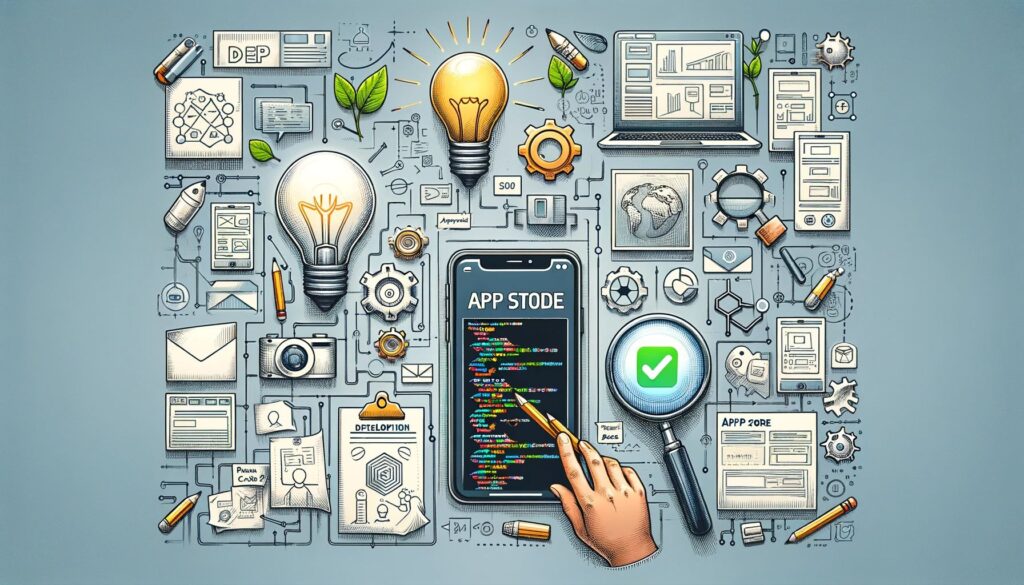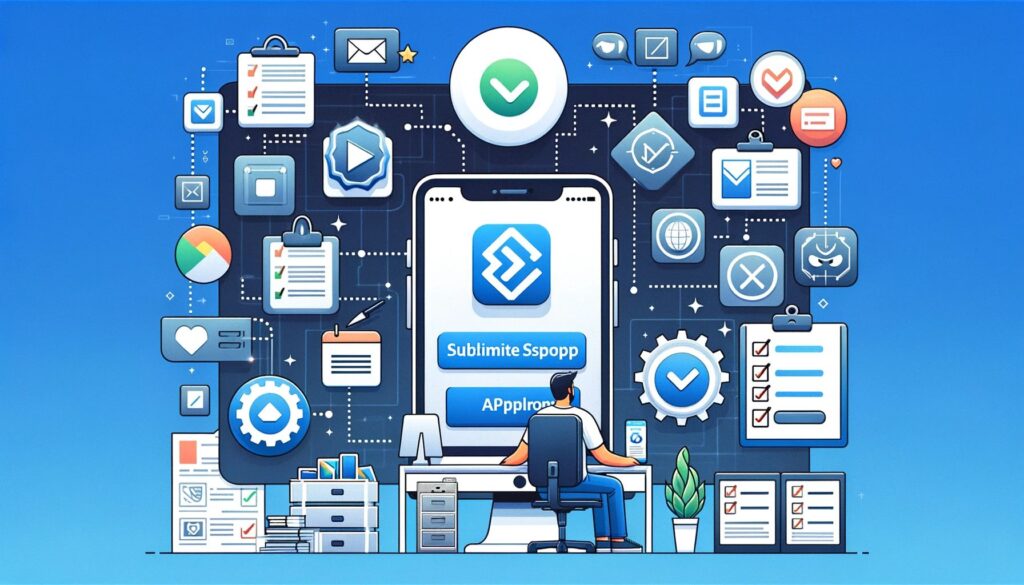Introduction: The Journey to Creating Your Mobile App
Creating a mobile app is a journey that begins with a single idea and evolves into a fully functional digital product used by potentially millions of users. The world of mobile apps is dynamic and ever-changing, with new technologies and user preferences shaping the way we interact with our mobile devices. This journey, while exciting, is filled with critical decisions and meticulous processes that shape the success of the final product.
The Landscape of Mobile App Development
The mobile app market is vast and diverse, encompassing everything from simple utility apps to complex social media platforms and advanced gaming experiences. The global app market continues to grow, with millions of apps available on various platforms like the Apple App Store and Google Play Store. This growth reflects not only the increasing number of smartphone users but also a shift in how we conduct daily activities – shopping, learning, working, and entertainment – all through apps.
Understanding the App Creation Process
Creating a mobile app requires careful planning and execution. It’s not just about coding; it involves understanding user needs, designing engaging interfaces, choosing the right technologies, testing for quality, and navigating the complexities of app store approvals. Each stage of this process is crucial and contributes to the overall user experience of the app.

- Idea Generation and Validation: Every app starts with an idea. But not all ideas are viable. It’s essential to validate your app idea by researching the market, identifying potential competitors, and understanding your target audience’s needs.
- Designing the App: A well-designed app is not just about aesthetics but also about functionality and user experience. This involves creating wireframes, mockups, and user journeys that provide a blueprint of the app’s functionality and look.
- Technical Considerations: Choosing the right technology stack is critical. This includes deciding between native and cross-platform development, selecting programming languages, and considering the technical requirements for integrating features like databases, APIs, and cloud services.
- Development: This is where the actual building of the app takes place. It involves writing code, integrating databases, and implementing functionalities as per the design specifications.
- Testing: A critical phase where the app is rigorously tested for bugs, performance issues, and usability. This step ensures that the final product is stable and offers a smooth user experience.
- Launch and Marketing: Once the app is developed and tested, it’s time for the launch. This phase involves submitting the app to app stores, creating marketing materials, and planning promotional activities to attract users.
- Maintenance and Updates: Post-launch, the app needs regular updates and maintenance to keep it relevant, fix any issues, and improve based on user feedback.
This article aims to guide you through each of these stages, providing insights and practical advice to help you successfully navigate the complex yet rewarding process of creating and publishing your own mobile app. Let’s embark on this journey together, turning your innovative idea into a thriving mobile application that resonates with users worldwide.
Conceptualizing Your App Idea
Brainstorming and Refining App Ideas
The first step in creating a mobile app is to come up with an idea. This idea is the foundation upon which everything else is built. Brainstorming is a critical process where you explore different concepts, consider various functionalities, and envision the purpose of the app. To refine your idea, ask yourself questions like:
- What problem does my app solve?
- Who is the target audience for my app?
- Are there similar apps in the market, and how will mine be different?
It’s important not just to have an idea but to refine it into something practical and appealing to your target audience.
Conducting Market Research
Once you have a solid app idea, the next step is market research. This involves understanding the competitive landscape and the needs of your potential users. Here are some strategies:
- Competitor Analysis: Look at similar apps in the market. Analyze their features, user interface, and user reviews. This helps in identifying gaps in the market that your app could fill.
- Target Audience Identification: Define who your app is for. Conduct surveys, interviews, or use social media to understand their preferences, pain points, and expectations.
- Trend Analysis: Stay updated with current trends in the app world. This can be done by following tech blogs, attending webinars, and joining developer communities.
Validating Your Idea
The validation of your app idea is a crucial step. It involves testing your concept to see if it has a potential market. This can be done through:
- Creating a Minimum Viable Product (MVP): Develop a basic version of your app with core features and test it with a small group of users.
- Feedback Gathering: Use feedback from your MVP testing to understand what users like and don’t like about your app.
- Iterative Development: Refine your app based on feedback. This iterative process helps in shaping your app to better fit the needs of your target audience.
Planning and Designing Your App

Creating a Detailed App Blueprint
Once your app idea is conceptualized and validated, it’s time to plan and design the app. This stage is where you turn abstract ideas into concrete plans.
- Developing Wireframes:
- Wireframes are simple, black-and-white layouts that outline the size and placement of elements in your app.
- They serve as the blueprint for your app and help you visualize the user journey.
- Creating Mockups:
- Mockups are more detailed than wireframes and include color schemes, graphics, and a basic representation of the final design.
- They provide a clearer picture of how the app will look and feel.
- User Experience (UX) Design:
- UX design focuses on the user journey and how they interact with your app.
- Consider navigation, ease of use, and the overall user journey through the app.
- User Interface (UI) Design:
- UI design deals with the visual elements of your app, like buttons, icons, and typography.
- A good UI design is intuitive and makes the app visually appealing.
Importance of UX and UI Design
- User-Centric Approach: Both UX and UI design should focus on the needs and preferences of the end user. This ensures that the app is not only functional but also enjoyable to use.
- Consistency: Maintaining consistency in design elements across the app helps in creating a seamless experience for users.
Design Tools and Prototyping
- Utilize design tools such as Adobe XD, Sketch, or Figma for creating wireframes and mockups.
- Develop interactive prototypes to simulate the app experience. Tools like InVision or Marvel can be used for prototyping.
Collaborative Design Process
- Engage with developers, designers, and stakeholders during the design process.
- Gather feedback from potential users and incorporate it into the design.
Choosing the Right Technology Stack
After finalizing the design of your app, the next critical step is selecting the appropriate technology stack. This decision has a significant impact on the functionality, performance, and scalability of your app.
Native vs. Cross-Platform Development
- Native Development:
- Involves building separate apps for each platform (iOS and Android).
- Languages used include Swift for iOS and Kotlin or Java for Android.
- Offers high performance and better user experience as it can fully utilize the device’s features.
- Cross-Platform Development:
- Allows you to write code once and deploy it across multiple platforms.
- Common tools include React Native, Flutter, and Xamarin.
- Can save time and resources, although it might not fully match the performance of native apps.
Selecting Programming Languages and Tools
- For iOS Apps: Swift is the preferred language, known for its speed, safety, and modern syntax.
- For Android Apps: Kotlin is recommended for its concise and expressive code.
- Cross-Platform Tools: React Native (JavaScript) and Flutter (Dart) are popular for their efficiency and ability to create a native-like experience.
Considering Backend Technologies
- Server-side Languages: Node.js, Ruby, and Python are widely used for their scalability and efficiency.
- Databases: Choose between SQL (like MySQL, PostgreSQL) and NoSQL (like MongoDB) based on your data structure and requirements.
Integrating APIs and Third-Party Services
- Use APIs for functionalities like payment processing, social media integration, and data analytics.
- Third-party services can help with features like push notifications, user authentication, and cloud storage.
Importance of Scalability and Security
- Ensure your technology stack can handle growing user numbers and data.
- Prioritize security features to protect user data and privacy.
Developing the App
With a solid plan, design, and technology stack in place, the next phase is developing your app. This is where your idea starts to come alive through code.

Writing the Code
- Front-end Development: This involves building the user interface and experience. It’s about turning your designs into a functional app.
- Back-end Development: This is where the logic of your app resides. The back-end includes server-side operations, database management, and application logic.
- Integrating APIs: Connect your app to third-party services using APIs for enhanced functionalities like payment gateways, social media sharing, etc.
Implementing Core Functionalities
- User Authentication: Implement secure login mechanisms. Consider using OAuth or token-based authentication for security.
- Data Storage: Decide whether your app needs local storage, cloud storage, or a combination. Ensure data is stored and retrieved efficiently.
- Push Notifications: Integrate push notifications to keep users engaged. Use services like Firebase Cloud Messaging (FCM) or Apple Push Notification Service (APNs).
Ensuring Quality with Version Control
- Use Version Control Systems: Tools like Git help manage changes to the source code, allowing multiple developers to work together efficiently.
- Regular Committing: Regularly commit your code to track changes and facilitate collaboration.
Testing and Debugging
- Unit Testing: Write tests for individual components to ensure they work as expected.
- Integration Testing: Check if different parts of your app work together seamlessly.
- Debugging: Use debugging tools available in your development environment to identify and fix issues.
Collaborative Development
- Code Reviews: Regular code reviews ensure code quality and consistency.
- Agile Methodology: Consider adopting Agile practices for iterative development and quicker feedback incorporation.
Developing an app is a complex process that requires attention to detail, a deep understanding of the technologies involved, and a commitment to creating a quality product. This phase is iterative, and you’ll likely go back and forth between coding, testing, and debugging to refine your app. The goal is to create an app that not only functions well but also delivers a great user experience.
Incorporating Essential Features
After the initial development phase, it’s crucial to focus on incorporating essential features that will make your app stand out and meet user expectations. These features not only enhance the functionality of your app but also contribute significantly to the user experience.
User Accounts and Profiles
- Implementation: Offer options for users to create and manage their accounts. This might include personal profiles, settings, and preferences.
- Security: Ensure user data is handled securely, especially when dealing with personal information.
Notifications
- Types of Notifications: Implement different types of notifications like push, in-app, or email notifications to engage users.
- Customization: Allow users to customize notification settings to avoid overwhelming them with unwanted messages.
Navigation and Search Functionality
- User-Friendly Navigation: Design an intuitive navigation system that allows users to easily find their way around your app.
- Search Features: Implement a robust search functionality, especially if your app contains a lot of content or products.
Integrating Emerging Technologies
- AI and Machine Learning: Use AI for features like personalized recommendations or chatbots.
- IoT Integration: If your app interacts with IoT devices, ensure seamless integration and communication between the app and these devices.
Social Media Integration
- Sharing Capabilities: Allow users to share content or achievements from your app on social media platforms.
- Login Convenience: Offer options to log in or sign up using social media accounts for user convenience.
Analytics
- User Behavior Tracking: Implement analytics to understand how users interact with your app. Tools like Google Analytics can be integrated for this purpose.
- Feedback Loop: Use analytics data to continuously improve your app based on user behavior and preferences.
E-commerce Features (If Applicable)
- Payment Integration: If your app involves transactions, integrate secure and reliable payment gateways.
- Shopping Cart and Checkout Process: Ensure the shopping experience is smooth and straightforward.
Offline Capabilities
- Data Caching: Store data locally so users can access some features of the app without an internet connection.
- Syncing: Make sure the app syncs data once the connection is restored.
Testing and Debugging
The testing and debugging phase is crucial in ensuring your app functions correctly and provides a smooth user experience. This stage involves identifying and fixing any issues that could affect performance, usability, or security.
Types of Testing
- Unit Testing:
- Tests individual components or functions for correctness.
- Useful for catching bugs early in the development process.
- Integration Testing:
- Checks how different parts of the app work together.
- Essential for ensuring that all components interact seamlessly.
- Performance Testing:
- Evaluates how the app performs under various conditions.
- Includes testing for load times, responsiveness, and handling of large data sets.
- Usability Testing:
- Focuses on the user experience.
- Involves real users testing the app to provide feedback on its ease of use and overall experience.
- Security Testing:
- Ensures that the app is secure against potential threats.
- Includes testing for vulnerabilities like data breaches and unauthorized access.
Debugging
- Using Debugging Tools: Most development environments come with built-in debugging tools that help identify and fix issues in the code.
- Log Analysis: Review logs to find clues about bugs or crashes.
- Iterative Process: Debugging is an ongoing process throughout development, especially after updates or new features are added.
Best Practices for Effective Testing and Debugging
- Test Early and Often: Don’t wait until the end of development to start testing. Integrate testing throughout the development process.
- Automate Where Possible: Automated testing can save time and ensure consistency in testing routines.
- Involve End Users: Real user feedback is invaluable. Consider beta testing with a group of target users.
- Keep Track of Issues: Use issue tracking systems to document, prioritize, and monitor the resolution of bugs.
The goal of this phase is not just to find and fix current issues but also to establish robust practices that prevent future problems. A well-tested app is more likely to provide a reliable and satisfying experience for its users, which is key to its success in the competitive app marketplace. Remember, testing and debugging are not one-time tasks but ongoing processes that continue even after the app is launched.
Navigating the App Store Submission Process
Once your app is developed, tested, and debugged, the next step is to prepare it for submission to app stores like Google Play Store and Apple App Store. This process requires careful attention to the guidelines and requirements of each platform.

Preparing for Submission
- App Store Guidelines:
- Familiarize yourself with the specific guidelines of each app store. Apple and Google have different requirements and review processes.
- Ensure your app complies with content policies, privacy rules, and technical specifications.
- Creating App Listings:
- Prepare engaging and informative app descriptions.
- Include high-quality screenshots and, if possible, a video that demonstrates the app’s functionality.
- Setting Up Metadata:
- Choose relevant keywords for app store optimization (ASO) to improve discoverability.
- Determine categories and subcategories that best fit your app.
- Determining Pricing and Monetization Strategy:
- Decide if your app will be free, paid, or have in-app purchases.
- Set up the payment mechanism for paid features or subscriptions, if applicable.
The Submission Process
- Create Developer Accounts: Register for developer accounts on the respective app stores.
- Submit the App for Review: Upload your app along with all required information and metadata. Follow the submission guidelines closely.
- Monitor the Review Process: App store reviews can take a few days to several weeks. Be prepared to respond to any queries or requests for additional information.
Post-Submission
- Addressing Rejections: If your app is rejected, review the feedback carefully, make necessary changes, and resubmit.
- App Updates: Plan for regular updates to your app. Updates are essential for fixing bugs, improving features, and keeping the app fresh.
Tips for a Successful Submission
- Thoroughly Test Your App: Ensure your app is free from major bugs and crashes. App stores are likely to reject apps that don’t meet basic quality standards.
- Pay Attention to Detail: Small details like app icons, descriptions, and screenshots can significantly impact the approval process.
- Understand the Review Guidelines: Each app store has its own set of review guidelines. Understanding these in advance can save time and effort.
Marketing and Launching Your App
After successfully navigating the app store submission process, the next critical phase is marketing and launching your app. This step is vital to ensure your app gains visibility and traction among potential users.

Building an Effective Marketing Strategy
- Identify Your Target Audience:
- Understand who your app is for and tailor your marketing messages to this group.
- Conduct market research to understand their preferences, habits, and where they spend time online.
- Develop a Strong Online Presence:
- Create a website or landing page for your app.
- Utilize social media platforms to build a community around your app.
- Content Marketing:
- Develop engaging content like blog posts, infographics, and videos to generate interest.
- Share stories about your app’s development, features, and how it can benefit users.
- Leverage App Store Optimization (ASO):
- Optimize your app store listing with relevant keywords, compelling descriptions, and eye-catching visuals.
- Encourage satisfied users to leave positive reviews and ratings.
- Utilize Email Marketing:
- Collect email addresses through your app or website.
- Send regular updates, offers, and news to keep users engaged.
- Invest in Paid Advertising:
- Consider using paid ads on social media, search engines, or within other apps.
- Target your ads to reach your specific audience.
Launching Your App
- Soft Launch: Consider a soft launch with a limited audience to gather initial feedback and make improvements.
- Official Launch: Plan an official launch date. Create hype through teasers, countdowns, and promotions.
- Launch Event: Host an online event or webinar to introduce your app. This can be a platform to demonstrate its features and answer questions.
Post-Launch Activities
- Monitor Performance: Use analytics to track user engagement, downloads, and feedback.
- Respond to Feedback: Quickly address any issues or concerns raised by users.
- Update Regularly: Continuously improve your app based on user feedback and analytics.
Tips for a Successful Launch
- Start Marketing Early: Begin building excitement and anticipation well before the launch date.
- Network and Collaborate: Reach out to influencers, bloggers, and other apps for cross-promotion opportunities.
- Track and Adapt: Be flexible and ready to adjust your marketing strategy based on performance and user feedback.
Post-Launch: Maintenance and Updates
After the excitement of your app’s launch, it’s crucial to shift your focus to maintenance and updates. This phase is key to sustaining the app’s performance, keeping users engaged, and staying competitive in the market.
Regular Maintenance
- Bug Fixes: Continuously monitor your app for any bugs or issues and fix them promptly. Regular updates can address these and improve overall app stability.
- Performance Optimization: Keep an eye on your app’s performance metrics. Make optimizations to ensure it runs smoothly across all devices and platforms.
Iterative Updates
- Feature Enhancements: Based on user feedback and behavior analytics, regularly update your app with new features or enhancements to existing ones.
- UI/UX Improvements: User preferences and design trends change over time. Update your app’s design to ensure it remains fresh and user-friendly.
Gathering and Implementing User Feedback
- User Reviews: Monitor user reviews in the app stores and respond to them, showing that you value user feedback.
- Surveys and User Testing: Conduct surveys or user testing sessions for more detailed feedback. This can provide insights into what features users want or what aspects of the app could be improved.
Keeping up with Technology
- Adapting to New Technologies: Stay updated with the latest technological advancements. Integrate new technologies that can enhance your app’s functionality.
- Compatibility Checks: Regularly update your app to ensure it’s compatible with the latest operating system updates and new devices.
Monitoring Key Metrics
- Usage Statistics: Track how users are interacting with your app. Metrics like daily active users (DAU) and retention rates can provide valuable insights.
- Performance Metrics: Keep an eye on the app’s performance metrics, such as load times and crash rates, to ensure optimal functionality.
Planning a Roadmap
- Future Enhancements: Develop a long-term roadmap for your app. Plan for future features and improvements based on user demands and market trends.
- Resource Allocation: Allocate resources for ongoing development and marketing to continue driving user engagement and growth.
Tips for Effective Post-Launch Management
- Stay User-Centric: Keep focusing on user needs and preferences. User satisfaction is key to the long-term success of your app.
- Be Proactive: Don’t wait for users to report problems. Regularly check and update your app to maintain its health and relevance.
- Embrace Change: The app market is dynamic. Be ready to adapt your app to meet changing user expectations and technological advancements.
Conclusion
As you embark on your app development journey, remember that it’s a blend of technical skill, creativity, and an understanding of your audience. Your journey from ideation to launch is filled with learning and growth opportunities. Each stage, from the initial concept to continuous updates after launch, contributes significantly to your app’s success. Keep your users at the center of your development process, and stay flexible and responsive to their needs and feedback.
The world of app development is dynamic and evolving. Stay informed about the latest trends and technologies, and be ready to adapt your app to meet these changes. The journey of creating and launching an app is challenging but deeply rewarding. With dedication, a user-focused approach, and a willingness to learn and adapt, your app can thrive in the competitive digital landscape, providing value to users and fulfilling your vision as a developer.




